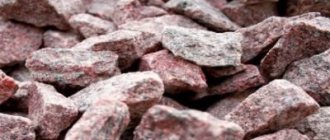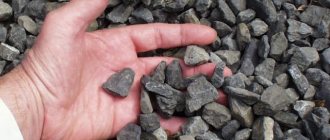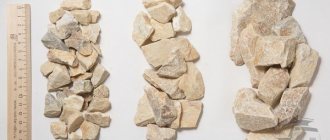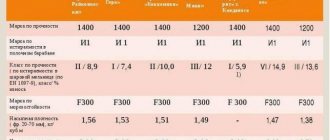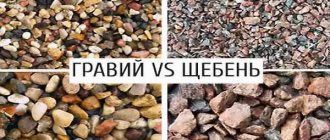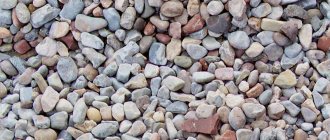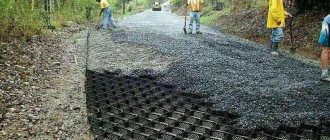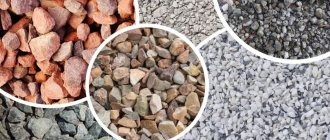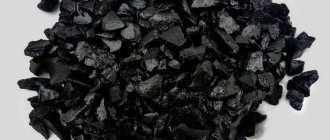- June 24, 2018
Modern requirements for high-quality building materials are increasing from year to year. It is the quality indicators of this representative of building materials that make it a leader in use. Its reliability and durability are higher than others. Popular at all times, the stone is a rock. In its pure natural form, it is frozen magma, rock. Extraction is carried out by crushing rocks using the explosive method. Then it is further crushed using special mechanisms. Production consists of crushing and sifting the rock mass using special mechanisms. This allows the entire mass to be divided by grain size, each of them has its own area of application and its own performance indicators. Overall though, they are similar.
Definition
The grade of crushed stone means the minimum strength of the rock. It directly depends on the characteristics of the underlying array. In addition to strength, the indicator hides the ability to withstand the number of freeze-thaw cycles, as well as abrasion. These quantities are not always related to each other.
The grades of crushed stone are given in GOST 8267-93 “Crushed stone and gravel from dense rocks for construction work.” It also contains standardization of material by fraction, flakiness, density and radioactivity and detailed technical characteristics.
Characteristics of crushed stone
Due to its strength, it is used in areas of high future loads on the object being built.
In terms of hardness, it is even ahead of marble! When polishing a product using it, it is possible to achieve a mirror result!
Important positive indicators:
- increased frost resistance, affects durability
- flakiness, large presence of cubic grains in the composition
- strength, depends on the amount of dust in the mass
- low radioactivity
- adhesion – increased adhesion to bitumen when laying asphalt
- ecological cleanliness
- high bulk density
- low moisture absorption
Strength
When choosing a coarse aggregate for concrete or bedding for a road surface, they are primarily guided by the strength of the stone. The crushability grade of crushed stone shows what minimum pressure the rock can withstand when tested for compression in a cone.
On this basis there is a single classification:
| Strength grade | Type | Description |
| M200, M300…M600 | Weak | Up to 15% inclusions of weak rocks |
| M600…M800 | Average | Maximum content of weak particles – 10% |
| M800…M1200 | Lasting | Weak particles up to 10% with increased tensile strength of the main stones |
| M1200 and above | High strength | Weak breeds no more than 5%. This group includes mainly slag and granite crushed stone |
The brand is influenced by several factors:
- specific gravity of crushed stone, which depends on the fraction and type of rock and averages 1340...1500 kg/m 3 ;
- hardness of the base rock. For example, slag pumice has a wide range of strength depending on the composition (M300... M1600), granite - no less than M1400, and weak limestone no more than M600;
- flatness of the main volume of the embankment. Flat-shaped stones are less durable than voluminous ones.
The optimal grade of crushed stone for road work is M800...M1200; for arranging pedestrian garden paths, M300-M400 is sufficient. In this case, GOST does not determine the frost resistance grade, but the abrasion value should be taken into account.
The grade of crushed stone for crushed stone preparation, as well as for the preparation of mortars, is determined by the need for reliability and expected loads. Usually M600...M1200 are used.
Frost resistance
The frost resistance grade of crushed stone means the minimum number of freezing/thawing cycles that the embankment can withstand. It is determined primarily by the density of the stones - the higher it is, the less water the crushed stone absorbs, the better it tolerates temperature changes.
The most impressive grades of granite crushed stone in terms of frost resistance are F350-F400. We can say that this material is durable and is not afraid of any weather influences. Crushed granite combines high strength with the ability to withstand freezing, making it an ideal component for outdoor construction work:
- construction of external walls of the house, basements, foundations;
- strengthening supporting walls;
- production of street structures that require high strength: paving slabs, road surfaces, curbs, embankment elements.
Due to its high cost, it is not used everywhere, mainly in private areas.
Crushed stone made from natural stone or artificial material with a less dense structure has lower frost resistance than granite.
Types of granite crushed stone
In the working process, it is divided by grain size.
Places of application of different sizes, crushed stone fractions:
- – coarse fraction – 40 -70mm
. They are used in the production of large volumes of ready-mixed concrete, also in the construction of airfield pavements, railway embankments, and road construction. Strength indicators M 1400 – M 1600; - – crushed stone
20 – 40mm, 20 – 60mm, is also in special demand among builders. Used for the production of concrete. Pouring foundations, construction of highways, concrete pillars, supports, bridge floors, paving slabs... Strength indicators M 1000 - M 1400; - – fraction
5 – 10, 5 – 20mm. The smallest, is in high demand due to the highest bulk density. Products using such crumbs have increased reliability and strength. Strength indicators M 1000 – M – 2000. Used in the production of concrete products - tiles, curbs. Concrete masses, bridges and supports, road surfaces; - – fraction
0 – 5mm, granite sand, screenings. Low cost - in fact, it is waste in production when crushing stone. Add to the solution to replace regular sand. Its cost is higher. Thus, the cost of the solution is reduced. It is also used as a topping for paths in parks, gardens, and playgrounds. Used in filters and dry construction mixtures. Strength grade M 1000. - – Rubble , rubble stone
. Due to its large size, it is used to make luxurious stone fences and decorate various objects, fountains, and park areas. It is also painted in the color required by the design. Also used in concrete mortars.
All fractions are used in construction, housing construction, and decoration. You understand for what purposes you need this or that material. Considering the increased cost, it is possible to partially replace it with a cheaper type. The main thing is not at the expense of quality.
Abrasion of crushed stone
The abrasion grade of crushed stone is determined in a laboratory in a test drum. The batch is loaded into the receiver, the circle is started at a certain speed for some time. The weight loss of the core stone mass is then measured. Based on the result, the stone is assigned a group:
| Wear resistance grade (group) | Weight loss during testing,% |
| I – I | Up to 25 |
| I – II | 25…35 |
| I – III | 35…45 |
| I – IV | 45…60 |
The degree of wear is important when choosing crushed stone for road construction. The higher it is, the better.
Crushed stone
(colloquially -
crushed stone
) - inorganic, granular, bulk material with grains larger than 5 mm (according to European standards - more than 3 mm), obtained by crushing rocks, gravel and boulders [1], incidentally mined overburden and host rocks or substandard waste mining enterprises for processing ores (ferrous, non-ferrous and rare metals of the metallurgical industry) and non-metallic minerals from other industries and subsequent sieving of crushed products.
Factions [edit | edit code]
| 1. | from 3 to 8 mm (so-called Eurocrushed stone) |
| 2. | from 5 to 10 mm |
| 3. | from 10 to 20 mm |
| 4. | St. 20 to 40 mm |
| 5. | St. 25 to 60 mm |
| 6. | St. 20 to 70 mm |
| 7. | St. 40 to 70 mm |
| 1. | from 5 to 10 mm |
| 2. | from 10 to 15 mm |
| 3 | from 15 to 20 mm |
| 4. | from 70 to 120 mm |
| 5. | from 100 to 300 mm |
Flakiness [edit | edit code]
Flaky grain content
— a parameter that determines the percentage content of flakier (needle-like) grains. In crushed stone, the content of grains of lamellar and needle-shaped forms is normalized. Lamellar and needle-shaped grains include grains whose thickness or width is three times or more less than their length. Based on the shape of the grains, crushed stone is divided into four groups:
| Group | Name | Content of lamellar and needle-shaped grains |
| I | cuboid | to 10 % |
| II | improved | 10—15 % |
| III | regular | 15—25 % |
| IV | 25—35 % |
The use of cube-shaped crushed stone gives the most dense compaction. The presence of lamellar and needle-shaped grains in crushed stone leads to an increase in intergranular voids in the mixture. When producing rubble concrete mixtures, this leads to an increase in the consumption of the binder component, which entails additional material costs. In addition, cube-shaped grains have greater strength than lamellar and needle-shaped grains. Consequently, the use of cube-shaped crushed stone in the production of rubble concrete mixtures is more economically feasible.
At the same time, in the construction of railways and highways, crushed stone with increased flakiness is used, since it has better drainage properties.
Properties of crushed stone
Its main properties and advantages are:
- – frost resistance
- – durability
- – strength
- – low flakiness
- – absence of dust and clay impurities
Low flakiness improves the quality of the concrete mass, reduces cement consumption, and thus reduces the cost of the solution.
The rough surface and cuboid shape of the grains allow for maximum compaction, increasing the quality of the concrete mass.
Durability [ edit | edit code]
The strength of crushed stone is characterized by the tensile strength of the original rock during compression, the crushability of crushed stone during compression (crushing) in the cylinder, and wear in the shelf drum. These indicators simulate the resistance of stone material under the influence of vehicles passing along the road and mechanical impacts during the construction of road structures (laying and compaction with rollers).
Depending on the brand, crushed stone is divided into groups: high-strength M1200-1400, strong M800-1200, medium-strength M600-800, weak-strength M300-600, very weak-strength M200.
In crushed stone, the content of grains of weak rocks is normalized with the ultimate strength of the original rock under compression in a water-saturated state of up to 20 MPa. According to GOST 8267-93, crushed stone of grades M1400, M1200, M1000 should not contain grains of weak rocks in an amount of more than 5%, crushed stone of grades M800, M600, M400 more than 10%, crushed stone of grades M300 and M200 more than 15% by weight.
Granite crushed stone with a strength of M1200 is in greatest demand; high-strength crushed granite or basalt crushed stone with a strength grade of M1400-1600 is less commonly used. It is mainly used in the production of heavy, high-strength concrete, in load-bearing bridge structures, and foundations.
Composition of crushed stone
Its main components are quartz, various minerals, mica, and feldspar. It is this that gives granite its various shades. If the stone is translucent, it contains a lot of quartz. Due to the presence of different compositions in its base, the concrete mixture can have a different shade - green, gray, red. In some cases, it is necessary to diversify the color scheme of concrete. In this case, a combination of granite and limestone crushed stone works. It is also possible to add color to the solution.
Radioactivity of rubble [edit | edit code]
Radioactivity of crushed stone - characteristics. If the product must be suitable for all types of construction work without exception, which must be confirmed by relevant certificates and sanitary-epidemiological reports, special studies. laboratories, this means that all supplied granite crushed stone and other types of high-strength crushed stone belong to class I in radioactivity (the specific effective activity of natural radionuclides Aeff must be less than 370 Bq/kg). For the construction of roads within populated areas, crushed stone of class II radioactivity is suitable (Aeff should be less than 740 Bq/kg).
Types of crushed stone [edit | edit code]
Crushed granite [edit | edit code]
Granite crushed stone
is crushed stone made from solid rock with a granular structure, which is the most common on Earth. Granite rock is magma frozen at great depths. Consisting of well-formed crystals of feldspar, quartz, mica, etc. And has a color of red, pink or gray, depending on the predominance of spar and mica in it. Blocks are usually obtained by exploding a monolithic rock, then they are crushed in a machine, and the resulting crushed stone is sifted into fractions. This is the last stage of crushed stone production.
Granite crushed stone fractions
- 0-5 mm (granite screening-ShchPS) is the smallest fraction of granite crushed stone, in the strict sense it does not belong to crushed stone, but is a by-product during its production. It is used as a decorative material for finishing, as well as for filling paths and roads, children's and sports grounds; for the manufacture of concrete products, in particular with the surface of “washed concrete”;
- 0—10 mm (ShchPS)
- 5-10 mm is the finest fraction commercially available. Used in the production of concrete and structures made from it to optimize the fractional composition of coarse aggregate, for example in the production of floor slabs using a formless method;
- 5-20 mm (a mixture of fractions 5-10 and 10-20) - is in greatest demand. Used in the production of concrete and structures made from it, in foundation work, when pouring bridge structures, bridge decks, road and airfield surfaces;
- 20-40 mm - average fraction. It is used in the production of concrete, reinforced concrete structures, in the construction of roads and railways, tram lines, in laying foundations and erecting industrial buildings;
- 25-60 mm - fraction used in the construction of foundations for railway tracks;
- 20-70 mm, 40-70 mm - coarse fraction, used in the production of concrete, massive structures made from it and for work with large volumes of concrete. It is also used in road construction within populated areas, during the construction of industrial buildings and structures;
- 70-120 mm, 120-150 mm, 150-300 mm (RUB) - rubble stone, used for backfilling, in gabions, for decorative purposes, usually for finishing fences, reservoirs, pools.
These are the standard, most common ways to use these fractions of granite crushed stone, however, for each of them there are many application options.
According to technical characteristics, granite crushed stone is durable (grade 800-1200) and high-strength (grade 1400-1600), frost-resistant (grade 300-400), with low flakiness (5-23%) and class 1 specific effective activity Aef (less than 370 Bq /kg).
The good properties of granite make it a popular building material. This is the best aggregate for high-quality concrete. Granite is also used as a decorative stone. It can be gray, red or pink and has many shades, after sanding and polishing it has a beautiful mirror surface. Granite mainly consists of feldspar, quartz, and mica crystals, the content of which affects the color and shades of the stone.
Crushed gravel [ edit | edit code]
Crushed gravel
- crushed stone obtained by crushing gravel into various fractions - 3-10 mm, 5-20 mm, 5-40 mm, 20-40 mm. Crushed gravel is used for foundation work, for concrete, in the production of reinforced concrete products, and in road construction. Crushed gravel is gravel that has been crushed by crushing or any other mechanical method and has 2 or more chipped sides of the stone.
Crushed limestone [edit | edit code]
A product of crushing limestone, consisting mainly of calcite (calcium carbonate - CaCO3).
Limestone crushed stone (sometimes also called limestone or dolomite crushed stone) is one of the main types of crushed stone, which, in addition to gravel and granite crushed stone, is used in road construction, as well as in the manufacture of reinforced concrete products. It is also allowed to be used in drainage installations, provided that it has a sufficiently dense structure.
Recycled crushed stone [edit | edit code]
Crushed stone obtained by crushing construction waste - concrete, brick, asphalt. The standards are described in GOST 25137-82. To obtain it, the same equipment is used as in the production of other types of crushed stone, the process consists of the following main stages: first, construction waste is placed into the feeder hopper using a loader, then the crusher breaks large pieces into crushed stone, after which metal inclusions are sampled ( for scrap metal) and further fractionation of crushed stone on a screen (the unsorted fraction is also in demand).
Crushed stone from gravel rocks with a fraction of 20-40 mm
Crushed gravel fr. 20-40 mm can be obtained by crushing quartz diorite or granite. It belongs to the mid-fraction type, and is quite durable, since granite is considered the hardest rock. Gravel is used for the construction of buildings or the production of concrete structures that will subsequently be subject to heavy loads. It is considered one of the most common building materials.
Main characteristics
The 20-40 mm fraction is purchased much more often than others, since its scope ranges from decorative purposes to the creation of load-bearing reinforced concrete elements.
Technical specifications:
- Radioactivity is class 1, which indicates minimal danger when using it. Suitable for the construction of civil, industrial, agricultural buildings and structures.
- Strength - has a fairly high index for compression and wear - M800-M1200. The test is carried out using a special drum, where crushed stone is crushed.
- Density - directly affects strength and is approximately 1400 kg/m3. There are true, general and bulk. The first can only be obtained in laboratory conditions with the deduction of voids between the grains. When purchasing, you need to look at the availability of laboratory reports, since the price depends on this.
- Porosity is relatively small, which characterizes low water absorption and good water throughput.
- Frost resistance - able to withstand more than 200 cycles of freezing and thawing without loss of technical properties. Branded F200-F400.
- Adhesion – due to the high content of cuboid and acute-angled grains, excellent adhesion to cement in concrete mortar is ensured.
- Flakiness - the presence of flat elements is only 10% of the total mass, which makes it possible to achieve good compaction.
Area of use
Often, crushed gravel stone of a fraction of 20-40 mm is used for the manufacture of load-bearing concrete products, foundations, and drainage systems. Also popular in landscape design and paving construction. For certain purposes, a certain material is selected according to suitable characteristics.
Factionality is one of the most important parameters that is taken into account when purchasing. The cost of medium-fraction gravel is slightly higher than coarse aggregate, since its production requires greater labor costs.
Delivery is carried out by dump trucks in bulk form, after which it can be used to decorate park areas and private areas. But more often it is used for preparing solutions, decorating facades, and strengthening concrete structures.
Cost of crushed stone 20-40 mm
| Name | Price per cube, rubles | |
| Gravel | 5-20 | 2000 |
| 20-40 | 1900 | |
Author: Valentin Tokarev
| Related articles: | |
| Types of crushed stone, its fractions and scope of application Which paint is best for making colored crushed stone? What is crushed foam glass used for? | |
